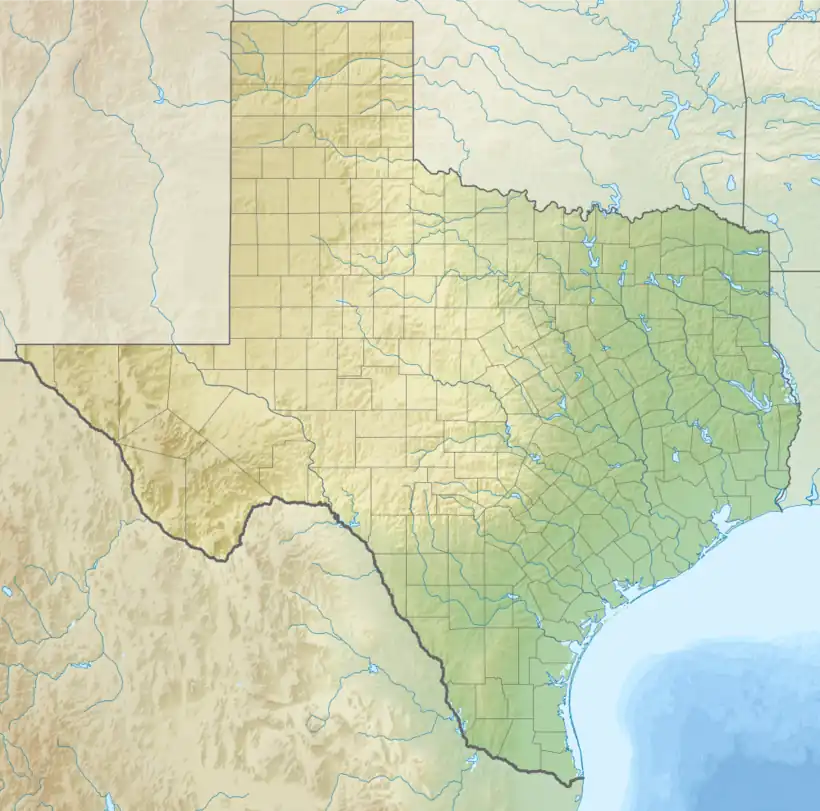Broadway Cemetery Historic District | |
 The Old City Cemetery in Galveston, Texas | |
 Broadway Cemetery Historic District  Broadway Cemetery Historic District | |
| Location | Six city blocks between Broadway Avenue (north) and Avenue L (south) and 43rd Street (west) and 40th Street (east) Galveston, Galveston County, Texas, U.S. |
|---|---|
| Coordinates | 29°17′37″N 94°48′46″W / 29.2935°N 94.8129°W |
| Area | 15.27 acres |
| NRHP reference No. | 14000340[1] |
| Added to NRHP | June 13, 2014 |
The Broadway Cemetery Historic District covers an area of 15.27 acres,[2] a six-block collective of seven separate cemeteries in the city of Galveston, Texas. The architectural styles displayed in these cemeteries run a gamut of categories: late 19th and early 20th Century Revivals: Beaux Arts, Colonial Revival, Classical Revival, Italian Renaissance and Late Gothic Revival.[3] It has been listed on the National Register of Historic Places since 2014.[4]
History
Galveston, Texas was hit hard with nine yellow fever epidemics during the period 1839 through 1867, necessitating additional public burial sites. At the time, it was the largest city in Texas, and was the seaport of entry for the state. It is estimated that in 1853, 60 percent of its population was affected by the yellow fever crisis, with a death toll of 523.[5] The island's last yellow fever epidemic in 1867 killed hundreds. With the onset of that health crisis, thousands fled the island. One resident who stayed behind remembered that the victims "died on the island like sheep.”[6]
Old City Cemetery (1839)
- This was the first cemetery established as part of the original town charter in 1839. Its history is the source of rumors and folklore. It is alleged to be haunted by Thomas Nicaragua Smith, executed as a deserter from the Confederate Army during the American Civil War. The remains of Elize Alberti and her family also come with a legend. She is alleged to have murdered her own children.[7]
Oleander Cemetery (1839)
- Established in 1839 as Potter's Field cemetery, it was originally for unclaimed or indigent people. During the Franklin D. Roosevelt New Deal Works Progress Administration (WPA) agenda, a Galveston city ordinance renamed it Oleander Cemetery in 1939. During this period, the cemetery was reconfigured.[3]
Evergreen Cemetery (1839)
- Estimated 900 interments, the majority interred 1839–1964.[8]
The Old Catholic Cemetery (c. 1844)
- Established by the Archdiocese of Galveston-Houston.[9][3]
Episcopal Cemetery (1844)
- This was created in 1844 on land deeded to the Rector of the Episcopal Church. A brick wall and concrete walks were added later. There are estimated to be over 1,000 interments.[10]
Hebrew Benevolent Society Cemetery (1868)
- More than 500 interments. Isadore Dyer donated a plot of land in 1852, for use by the Jewish Cemetery Association. The first individual burial plots were acquired in 1867 and 1897.[11]
The New City Cemetery (1900)
- Established in response to the 1900 Galveston hurricane that claimed thousands of lives.[12]
See also
References
- ↑ "National Register Information System". National Register of Historic Places. National Park Service. November 2, 2013.
- ↑ Wolfe 2014, p. 4.
- 1 2 3 Wolfe 2014, p. 9.
- ↑ "Broadway Cemetery Historic District". National Register of Historic Places Registration Form, National Park Service (NPS). May 16, 2014.
- ↑ Burns, Chester R.; Wooten, Heathr Green. "Epidemic Diseases". Handbook of Texas Online. Texas State Historical Association. Retrieved September 19, 2021.
- ↑ Teston, Jacy; Meek, Mason. "Yellow Fever in Galveston, Texas - "Those Remaining Died on the Island like Sheep"". East Texas History. Sam Houston State University. Retrieved September 19, 2021.
- ↑ Block, W. T. "Ghost of Nicaragua Smith Haunts Old City Cemetery in Galveston". www.texasescapes.com. Blueprints For Travel, LLC. Retrieved September 19, 2021.; Sault, Spring (May 30, 2019). "Is Galveston's Old City Cemetery the Most Haunted Graveyard in Texas?". Texas Hill Country. Retrieved September 19, 2021.
- ↑ "Evergreen Cemetery". www.waymarking.com. Waymarking.com. Retrieved September 19, 2021.
- ↑ "Old Catholic Cemetery". www.waymarking.com. Waymarking.com. Retrieved September 19, 2021.; "Old Catholic Cemetery". Texas Gravestone Photo Project. Retrieved September 19, 2021.
- ↑ Wolfe 2014, pp. 9–10, 14.
- ↑ Adler, Cyrus; Cohen, Henry. "Galveston". JewishEncyclopedia. The Kopelman Foundaion. Retrieved September 19, 2021.; "Hebrew Benevolent Society Cemetery – Galveston, TX". Waymarking.com. Retrieved September 19, 2021.
- ↑ Weems, John Edward. "Galveston Hurricane of 1900". Handbook of Texas Online. Texas State Historical Association. Retrieved September 19, 2021.
Additional sourcing
- Wolfe, Mark (2014). "Broadway Cemetery Historic District" (PDF). NPS. United States Department of the Interior.
- "Recent Listing: Broadway Cemetery Historic District, Galveston | THC.Texas.gov – Texas Historical Commission". Texas Historic Sites Atlas. Texas Historical Commission. Retrieved September 19, 2021.
- "Broadway Cemetery Historic District, Galveston, TX". Historic Houston. November 18, 2015. Retrieved September 19, 2021.
- "Details – Broadway Cemetery Historic District – Atlas Number 2014000340 – Atlas: Texas Historical Commission". atlas.thc.state.tx.us. Texas Historical Commission. Retrieved September 19, 2021.
- "The Ghosts of Broadway Cemetery on Galveston Island". Ghost City Tours. Retrieved September 19, 2021.